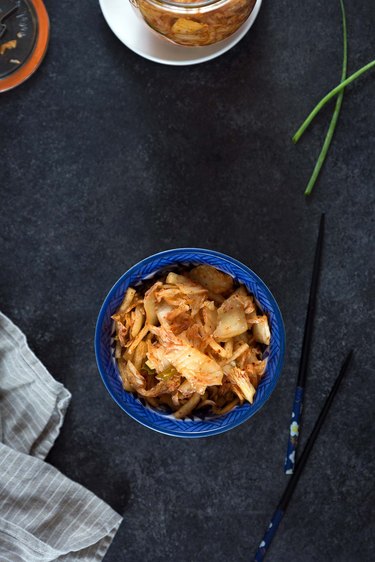
If you're not familiar with kimchi, a classic Korean banchan (side dish), the description may not sound too appetizing: assorted vegetables and other ingredients that are salted and then (historically) buried underground and left to ferment. But don't let the description scare you off — kimchi is delicious by itself or as an accompaniment to other dishes. And these days, there's no reason to go to the trouble of burying kimchi; all you need is a glass jar with a lid.
If you'd like to make kimchi at home, this easy kimchi recipe will walk you through everything you need to know. While there are hundreds of kimchi varieties, our traditional kimchi recipe shows you how to make a basic version using two of the most common ingredients: napa cabbage and daikon radish.
Video of the Day
Things You'll Need
2 lbs. napa cabbage, sliced
1/2 cup kosher salt
4 medium cloves garlic, minced
1 to 4 Tbsp. gochugaru (Korean red pepper flakes)
1 Tbsp. fresh ginger
2 Tbsp. fish sauce
1 1/2 tsp. granulated sugar
8 oz. daikon radish, peeled and sliced into 2-in. matchsticks
4 scallions, sliced into 1-in. pieces
2-qt. jar or two 1-qt. jars
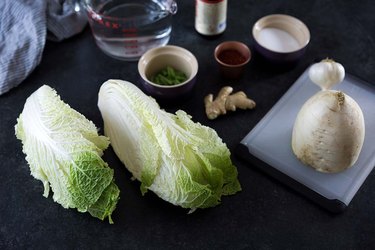
What are the ingredients in kimchi?
A traditional kimchi recipe calls for ingredients that may be difficult to locate if you don't have an Asian market nearby. Napa cabbage and daikon radish are the main components in a traditional kimchi recipe, but if you're unable to find them in your area, you can substitute with any large green cabbage variety and leave out the radish altogether. It's best not to substitute another radish for daikon, as it may impart a more bitter taste. If you're unable to locate gochugaru in stores, it can be purchased from online retailers.
1. Salt the cabbage
Place the cabbage in a large bowl and top it with salt. Massage the salt into the cabbage for a few minutes.

2. Add water
Top with cold water until the cabbage is completely submerged. Cover the bowl with plastic film and let it stand at room temperature for at least 3 hours or up to 1 day. Drain and rinse the cabbage and then allow it to dry.

3. Prepare the paste
In a small bowl, combine the garlic, gochugaru, ginger, fish sauce, and sugar to form a paste. How much gochugaru to add depends on your own personal preference for heat.
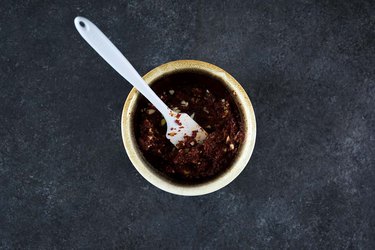
4. Mix the ingredients
In a large bowl, combine the cabbage, daikon radish, scallions, and paste until evenly mixed.
Tip
Mixing is best done with your hands, but wear kitchen gloves because it's a potent mix!
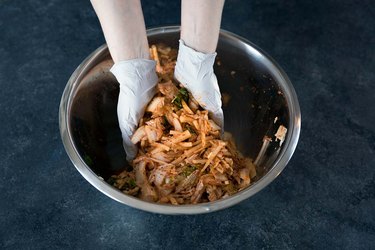
5. Pack the kimchi in a sealable jar
Pack the kimchi inside one 2-quart or two 1-quart jars, pressing down tightly as you go. A brine will start rising to the surface; this is a good thing. If there's no brine, wait several minutes before continuing. It will start to develop as the vegetables begin to release liquid. Leave 1 to 2 inches of space at the top of the jar.
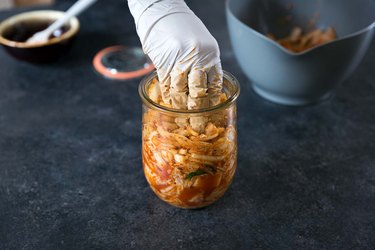
6. Ferment the kimchi
Close the lid and store the kimchi at room temperature for 1 week. It's a good idea to place the jar on a plate or in a bowl because as the mixture ferments, liquid might seep out of the jar. Once per day, push down on the kimchi to help the brine coat the vegetables evenly.
After fermenting, transfer the jar to the refrigerator. The flavor will continue to develop over time.
Is kimchi healthy?
You'll be happy to know that kimchi does indeed provide many health benefits. It's low in fat and calories and full of nutrients as well as probiotics, which help promote a healthy gut.
